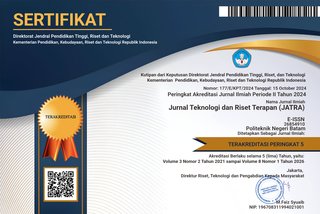Pengaruh Proses Tacking dan Welding Sequence Terhadap Distorsi Pada Pengelasan Butt Joint Pipa Dengan Flange Berbahan Carbon Steel
DOI:
https://doi.org/10.30871/jatra.v5i2.6893Keywords:
Distortion, Spool Pipe, Tacking, Flange, Welding SequencesAbstract
This research explores the issue of distortion in spool pipes within the context of the fabrication process, with a specific focus on pipe connections with flanges. The main objective of this study is to investigate the impact of distortion caused by the tacking process during fit-up and the sequence of welding sequences in the welding process. The experiments were conducted by collecting data through inspections of concentricity in the connections using the Total Station Sokkia CX 101 S/N GP1159 tool, with tolerances set at 1, and 0.75 for capping weld. Fabrication Piping and Structure Onshore served as the testing location, with ASTM A671 CC60-12 as the testing material. All tests were conducted at room temperature. The inspection results were used as a guide for the repair process, providing instructions to the Fitter for improving the connections and enabling the welder to maintain the precision of the pipe connections with flanges to avoid distortion. Based on the experimental results, the concentricity of pipe connections reflects the occurring distortion, while welding sequences show a counter effect at each welding step. The distortion after welding, measured at 0.75, still complies with client specifications.
Downloads
References
H. Wang, Z. Wang, P. Bai, S. Hu, Y. Zhang, and R. Wang, "Optimized segmented heat source for the numerical simulation of welding-induced deformation in large structures," Advances in Engineering Software, vol. 117, pp. 1"“7, Mar. 2018, doi: 10.1016/J.ADVENGSOFT.2017.12.005.
M. De Abreu, M. Iordachescu, and A. Valiente, "Fatigue life assessment of a tack welded high-strength wire mesh for reinforcement of precast concrete bridge girders," Constr Build Mater, vol. Volume 197, no. ISSN 0950-0618, pp. 421-427, 2019.
M.Panji, A.S Baskoro, and A widyianto, "Effect of Welding Current and Welding Speed on Weld Geometry and Distortion in TIG Welding of A36 Mild Steel Pipe with V-Groove Joint," in IOP Conference Series: Materials Science and Engineering, , 694, 012026, IOP Publishing, 2019.
Agus Widdyianto, Ario Sunar Baskoro, Ganjar Kiswanto, and M Fathin Ginanjar Ganeswara, "Effect of Welding sequence and welding current on distortion, mechanical properties and metallurgical observations of Orbital pipe welding on SS 316L," Eastern - Europian Journal of Enterprise Technologies, vol. 2, no. (12 (110)), pp. 22"“31, 2021, doi: DOI: 10.15587/1729-4061.2021.228161.
I. Sattari-Far and Y. Javadi, "Influence of welding sequence on welding distortions in pipes," International Journal of Pressure Vessels and Piping, vol. 85, no. Published by Elsevier Ltd., pp. 265"“274, Jul. 2007, doi: doi:10.1016/j.ijpvp.2007.07.003.
M. Abid and M. Siddique, "Numerical simulation to study the effect of tack welds and root gap on welding deformations and residual stresses of a pipe-flange joint," International Journal of Pressure Vessels and Piping, vol. 82, no. 2005 Elsevier Ltd, pp. 860"“871, Jun. 2005.
Romero, Jesus Saha, Baidya Toledo, Gengis, Beltran-Bqz, and David, " Welding sequence Optimization Using Artificial Intelligence Techniques, an Overview," SSRG International Journal of Computer Science and Engineering (SSRG-IJCSE), vol. 3, pp. 91"“95, Jan. 2016.
Chunbiao Wu, Chao Wang, and Jae-Woong Kim, "Welding sequence optimization to reduce welding distortion based on coupled artificial neural network and swarm intelligence algorithm," Eng Appl Artif Intell, vol. Volume 114, no. ISSN 0952-1976, pp. 105"“142, 2022.
Biswas, Pankaj, Anil Kumar, and Deepati, "A Study on the Effect of Welding sequence in Fabrication of Large Stiffened Plate Panels," J. Marine. Sci. Appl, vol. 10, Jan. 2011.
PT SMOE, "Client Specification (Private file)," Batam, 2018.
PT SMOE, "WPS and PQR (Private file)," Batam, 2018.
Y. P. Yang, "Recent Advances in Prediction of Weld Residual Stress and Distortion "” Part 2," Weld J, vol. 100, no. 6, pp. 193S-206S, Jun. 2021, doi: 10.29391/2021.100.016.
Downloads
Published
How to Cite
Issue
Section
License
Copyright (c) 2023 Jurnal Teknologi dan Riset Terapan (JATRA)

This work is licensed under a Creative Commons Attribution-NonCommercial-ShareAlike 4.0 International License.




11.jpg)











